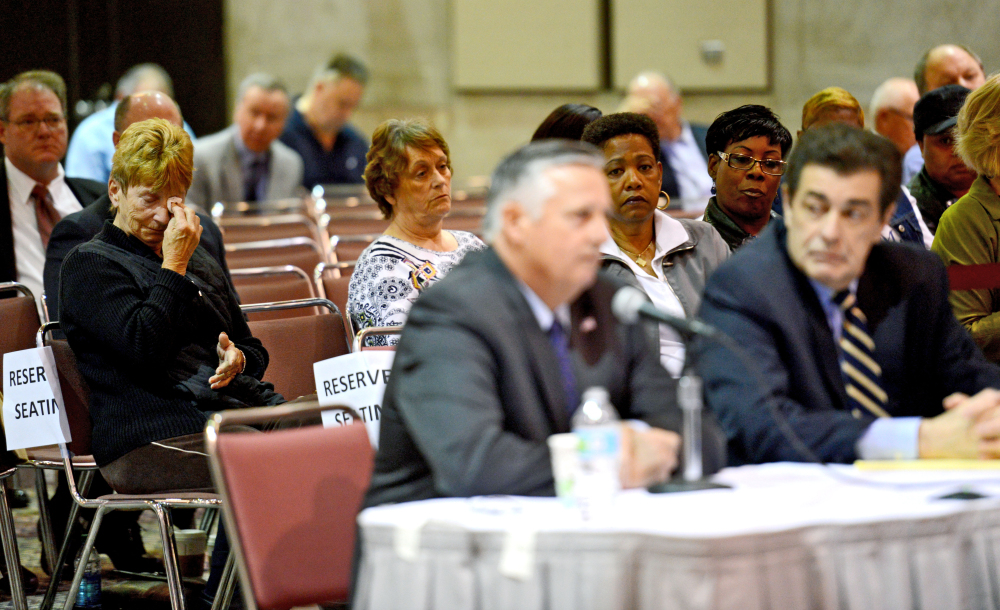JACKSONVILLE, Fla. — The captain of the freighter El Faro that sank in a hurricane last year refused to take vacation the day before his ill-fated voyage because he wanted to use the time off to be home for his 25th wedding anniversary, according to testimony Wednesday.
Head of labor relations for Tote Services Inc. Mick Kondracki said he emailed Capt. Michael Davidson of Windham about using vacation time on the day before El Faro left port in Jacksonville.
“He wanted to stay onboard so he could be home for his 25th wedding anniversary,” Kondracki said, his voice breaking from emotion. “It shows what a great guy he was.”
The 790-foot-long El Faro sank Oct. 1 after losing propulsion while sailing from Jacksonville to San Juan, Puerto Rico. The ship was hit by Hurricane Joaquin and all 33 crew aboard died.
Kondracki’s testimony came before a U.S. Coast Guard panel investigating whether misconduct or other problems led to the ship’s sinking in 15,000 feet of water near the Bahamas.
Testimony also revealed that Tote sent a company-wide safety alert out about a hurricane last summer, but did not send one before Joaquin.
Phil Greene, CEO and president of Tote Services, said safety personnel sent out an alert for Hurricane Danny last summer only because it was the first hurricane of the season. Investigators pointed out that Danny was the fourth named storm of the season, and questioned why no similar alert was sent out before Joaquin.
A tropical storm gets a name when it reaches sustained winds of 39 mph. It becomes a hurricane at 74 mph.
Greene said the alert was sent out before the earlier storm “in recognition of first hurricane of the season to remind all our vessels in all oceans to take the action of reviewing their plans.”
Lee Peterson, director of safety and marine operations for Tote, said he sometimes tracked storms and ships from his office onshore, but wasn’t do it for Joaquin. He was unaware if anyone else was watching the storm that became an intense Category 4 hurricane, with winds of at least 130 mph.
It is unclear why Davidson chose to take a route closer to the storm’s path rather than a longer, safer route that he had taken during previous storms such as Tropical Storm Erika. Investigators have not been able to recover the ship’s “black box” which would have recordings from the bridge that might shed light on that decision. The National Transportation Safety Board said it is planning to search the wreckage again in an attempt to find it.
“Do you know why the vessel would go southbound on the late August voyage … through the Old Bahama Channel than choose to go (a different route) for Hurricane Joaquin,” asked Coast Guard Cmdr. Mike Odom, a technical adviser to the board.
“I wish I could answer that,” Peterson said.
According to Greene, it was the captain’s responsibility to make sure the ship and its crew were safe, not onshore personnel. That includes choosing which route to take in bad weather.
“The authority for voyage planning resides with the master,” Greene said. “It’s at the master’s discretion to determine the best track.”
The hearing resumes Thursday and lasts through next week. The Coast Guard will hold another hearing later this year, and release a report. It can bring civil charges, and can forward any evidence of criminal wrongdoing to the U.S. Department of Justice for review.
Send questions/comments to the editors.




Success. Please wait for the page to reload. If the page does not reload within 5 seconds, please refresh the page.
Enter your email and password to access comments.
Hi, to comment on stories you must . This profile is in addition to your subscription and website login.
Already have a commenting profile? .
Invalid username/password.
Please check your email to confirm and complete your registration.
Only subscribers are eligible to post comments. Please subscribe or login first for digital access. Here’s why.
Use the form below to reset your password. When you've submitted your account email, we will send an email with a reset code.